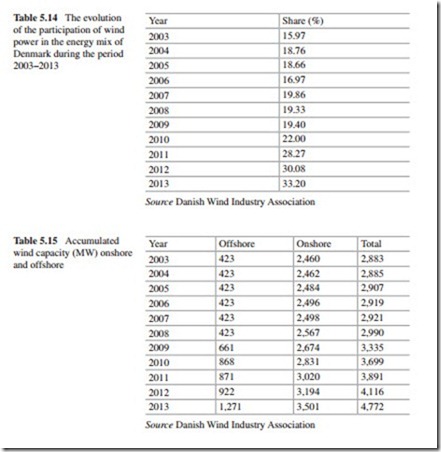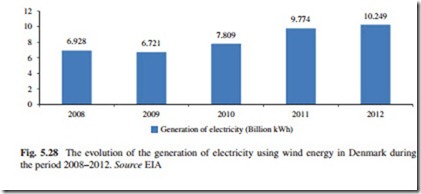Denmark
The Danish TSO Energinet has investigated the consequences of doubling the country’s approximately 3,000 MW of installed wind power to about 6,000 MW before 2025 (Energinet 2007; Eriksen and Orths 2008). About 2,000 MW is expected to be installed offshore. The objective to be reached by the change would be to increase wind power’s share of Danish electricity demand from 20 to 50 % during the coming decades. Assessments are made for the energy balance, the fuel consumption, the emissions, the power balance, the need for ancillary services, and the transmission grid. More generally, the study assesses the demands that integration of 50 % wind energy into the electricity system would place on flexibility in production, grid operation, and power consumption.
Due to an average growth of 715 MW per year, Danish offshore wind capacity remains the highest per capita in Europe. Two new offshore installations, each of 200 MW, are planned. Renewable energy sources other than offshore wind are slowly, but steadily penetrating the market supported by a wide array of measures such as a new repowering scheme for onshore wind.
The wind power capacity installed in the country during the period 1997– 2013 increased 4.5-fold (from 1,066 MM in 1997 to 4,772 MW in 2013). The wind power capacity installed represents 28.64 % of the total energy capacity is approximately 1,000,000 tons and 22,000 tons per year, respectively. These amounts of reduction will be further augmented to 1,500,000 and 35,000 tons in the future. The average maximum sea depth of construction is about 12 m, but within next years such establishments will be sited at 19 m (Karanikolas et al. 2011).
In order to increase the share of the use of wind power for the generation of electricity in the overall electricity consumption, Denmark has implemented the following measures:
• A tendering procedure has been used for two new large offshore wind installations. Operators will receive a spot price and initially a settling price as well. Subsequent offshore wind farms are to be developed on market conditions;
• A spot price, an environmental premium (€13 per MWh), and an additional
compensation for balancing costs (€3 per MWh) for 20 years are available for new onshore wind farms.
Denmark’s 3,136 MWe of wind power capacity met in 2006 represents a total of 20 % of its electricity needs, the largest share in any country. In 2013, the wind power capacity reached 4,772 MW, an increase of 52.2 % with respect to 2006; this wind power capacity satisfies 33.2 % of the country’s electricity needs in that year. The total wind farms in the country reached 1,510 in that year.
The evolution of the participation of wind power in the energy mix of the country is shown in Table 5.14.
The accumulated wind power capacity onshore and offshore in Denmark during the period 2003–2013 is included in Table 5.15.
Denmark is the global leader in offshore wind power installations, with 1,271 MW capacity installed in 2013. Wind is the cheapest form of renewable energy in Denmark, which is the main reason why this energy source attracts more investments. Wind energy is also the cheapest way in which the goals for Denmark’s green transi- tion are best achieved. It was expected that the country would see an increase in wind power capacity from 2012 to 2013 due to the commissioning of the Anholt offshore wind farm (400 MW), which was planned prior to the 2012 energy agreement entered into force.
Offshore wind turbines receive support in an average of 12–13 years, while onshore turbines are supported for an average of seven years. When the support scheme expires, turbines only receive the price rates determined by the electricity market.
Danish government’s policy is that by 2020, Denmark will be a green, sustainable society and the country will be among the three most energy efficient countries
in the OECD (Klima-og energiministeriet 2010). Denmark has a target of 30 % renewable energy by 2020. The government’s long-term energy–political vision is that Denmark will ultimately become independent of fossil fuels. Financial sup- port for electricity generation based on renewable energy is stated in Act No. 1392 of December 2008 on the Promotion of Renewable Energy.
In 2020, the Danish NREAP (2010) expects around 50 % of total electricity consumption to be met by renewables (Table 5.16). Almost 60 % of this will be wind, with biomass, essentially, making up the rest. The NREAP (2010) thus indicates that Denmark is on track to meet and, indeed, exceed its 30 % renewable target by 0.4 %. In the long term, Danish plans are for 100 % in the use of renewables for the generation of electricity.13
Denmark’s NREAP (2010) focuses to a large extent on managing consumption, and only a very slight increase in electricity demand is expected between 2010 and 2020. Moreover, the plan indicates that future policies aim to reduce energy consumption in 2020 by 4 % compared to 2006.
However, the Danish NREAP (2010) also forecasts a decrease in total installed onshore capacity from 3,501 MW to around 2,600 MW in 2020. This decrease is barely offset by the expected increase in offshore capacity, which is forecast at 1,339 MW in 2020; this represents an increase of 5.3 % with respect to 2013. Consequently, overall capacity increases are forecasting up to 2013; beyond that, apart from small net capacity additions in 2016 and 2017, in all other years, the country will register more capacity being decommissioned than put online. The plan contrasts with an EWEA’s scenario, where capacity is expected to reach between 6 and 6.5 GW by 2020. The Danish NREAP (2010) does not fully exploit the country’s repowering opportunities onshore and downplays the offshore potential. With 1,271 MW of offshore capacity online at end 2013, a net capacity increase of 68 MW is foreseen. However, it is important to highlight that the Danish government published a more ambitious new energy strategy with a target of receiving 50 % of its electricity from wind power on an annual basis by 2020. It looks like the country is well on its way to achieving that. The country also has a 2050 target of getting 100 % of its energy from renewable resources.
Generation of Electricity Using Wind Energy
The evolution of the generation of electricity using wind energy in Denmark during the period 2008–2012 is shown in Fig. 5.28.
According to Fig. 5.28, the generation of electricity using wind power in Denmark during the period 2008–2013 increased 47.9 %. It is expected that the use of this type of energy source by Denmark will continue increasing during the coming years, but in a slower rate. Undoubtedly, wind has become Denmark’s most prominent renew- able energy source. The country is now the second largest nation globally in terms of offshore wind power, accounting for around 7 % of the world’s total cumulative
offshore installed capacity. Denmark has set targets for developing 1.5 GW of new offshore capacity by the end of the same year. As a result, the government is increasingly supporting its offshore wind sector to help achieve these goals.


